Oriented Aroaces
and
Angled Aroaces

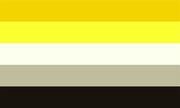
Made by Twitter user xredpaladinx
Types of attraction
As you might know, there are many forms of attraction –sexual and romantic attraction being the most well-known ones. So let's take a moment to describe some of them.
Sexual attraction is being attracted to someone in a way that makes you want to have sex with them or do sexual activities with them. It's the desire to have sexual contact with a specific person.
Romantic attraction is the desire to have what is considered to be a romantic relationship with a specific person. Some describe it as wanting to go on a date or do what they consider “romantic things” with that person.
Platonic attraction is the desire to be friends with someone. It can also be considered to be the desire to have a platonic relationship with a specific person.
Queerplatonic attraction is a specific subtype of platonic attraction. It's the desire to have a non-romantic relationship that involves an emotional connection that would be considered "more intense" than a friendship --a deep emotional connection that cannot be fully captured using existing relationship categories such as “romantic” or “friendship” (see queerplatonic relationships)
Alterous attraction can be considered to be somewhere between platonic and romantic attraction or a mix of both. It can also mean that the person feeling the attraction is not sure whether the attraction they're feeling is platonic or romantic.
Aesthetic attraction is finding someone visually appealing to look at, appreciating their appearance.
Sensual attraction is the desire to have physical contact with someone (for example: kissing, hugging, holding hands, cuddling). That contact isn't necessarily romantic or sexual, but it can be.
This attractions can overlap or be connected to each other (for example, it is possible to feel romantic and aesthetic attraction towards the same person), and it's not always easy to tell them apart. It's also important to note that behavior does not dictate orientation (an asexual person might have/like sex without feeling sexual attraction, an aromantic person might have/want a romantic relationship without feeling romantic attraction)
Non-romantic, non-sexual attractions are often called tertiary attractions.
what is an oriented aroace?

An oriented aroace is someone who doesn't feel sexual or romantic attraction, but experiences other kinds of attraction that they consider significant/important/intense enough to warrant a place alongside their aroace orientation.
This kinds of attraction are usually alterous and queerplatonic attraction –but take into account that some oriented aroaces can't (or don't want to) describe what types of attraction they feel–.
Most often, our attraction manifests as the desire to form committed partnerships with people of the gender(s) we're attracted to –although other experiences with non-romantic, non-sexual attractions exist as well.
It is also possible that an oriented aroace who is sex-favorable/indifferent or romance-favorable/indifferent uses that third label to indicate they still want sexual or romantic relationships with people of certain gender(s).
why add a third label?
Because our attraction is important to us, both in significance (“Do I find it important to make this distinction?”) and divergence (“Do I feel separate from other aroaces?”/“Do I feel our experiences are somewhat different?”). Some of us feel like outsiders in all three of our labels separately, so a united identity feels like coming home.
what is an angled aroace?
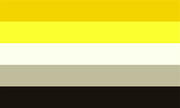
An angled aroace is someone who's both acespec and arospec –using aroace as an umbrella term– and experiences some form of attraction (this attraction can be tertiary attraction and/or sexual/romantic attraction). An angled aroace can be asexual and greyromantic, greysexual and aromantic, or both greysexual and greyromantic (greysexual/romantic being an umbrella term for all aspec identities that aren't strictly asexual or aromantic).
Usually, angled aroaces label the kind of attraction they do feel (whether it's sexual, romantic, or both), but they can also choose to label their tertiary attractions.
So what about gay/lesbian/bi aroaces?
As you might already be thinking, they are either oriented aroaces or angled aroaces.
When it comes to labels, the distinction between oriented and angled aroaces can be made by adding “-oriented” or “-angled” after the label (for example, lesbian-oriented aroace, bi-angled aroace, etc.), but often this suffix is omitted.
Often, the oriented and angled aroace flags consist of a heart with the colors of the flag of our third label with the oriented or angled aroace flag in the background. Some examples:
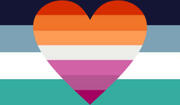
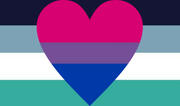
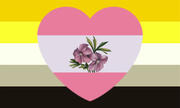
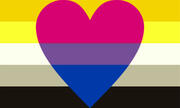
It's worth mentioning that there are some alternative flag designs that don't follow this format, and can be used as well. For example, the oriented aroace lesbian flag made by @theybian (shown below)

Oriented and angled aroaces can also use the oriented/angled aroace flag and their third label flag separately.
Thank you for reading!
It's okay if you don't fully understand it at the moment. It's always great to be understood, but at the end of the day, the most important thing is to be supported and respected.
If you have any questions I could maybe give an answer to, you can dm me on twitter (just remember to be respectful).
And if you want to learn more about aspec people, you can check out this carrd about asexuality and this carrd about the aromantic spectrum.